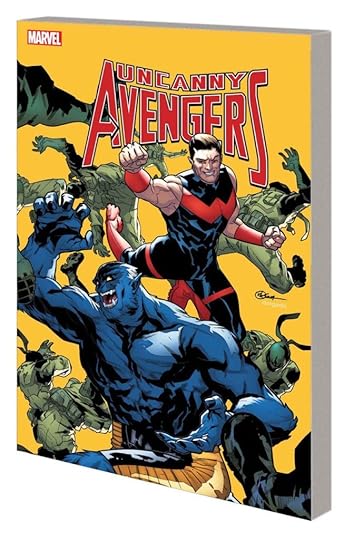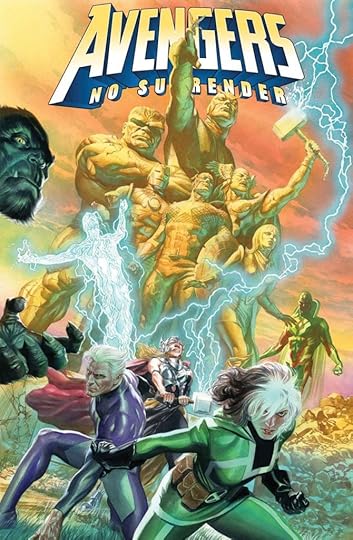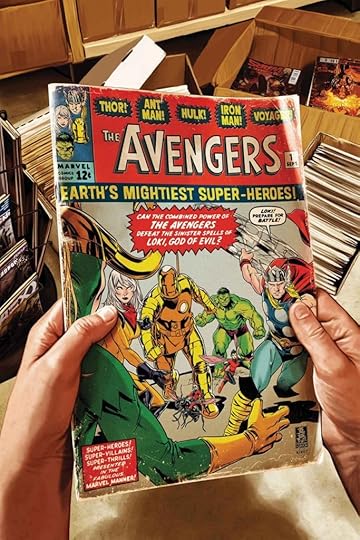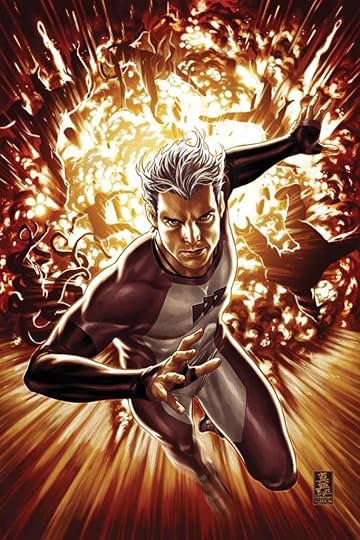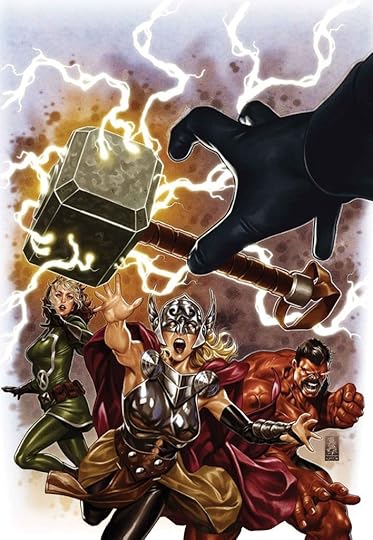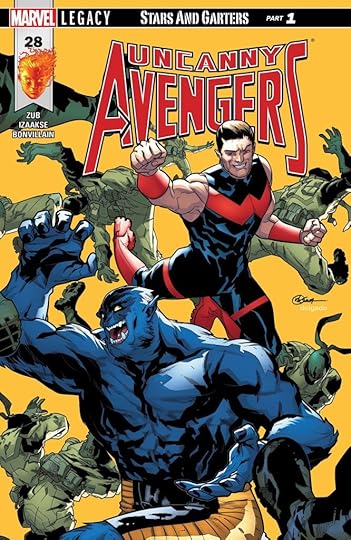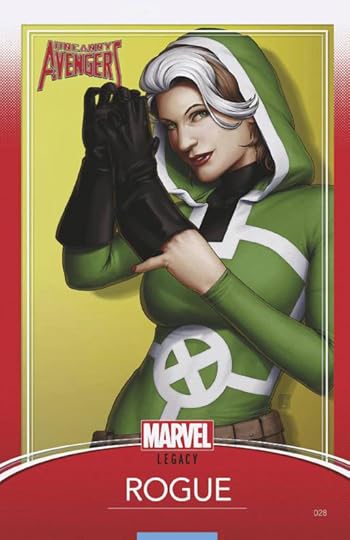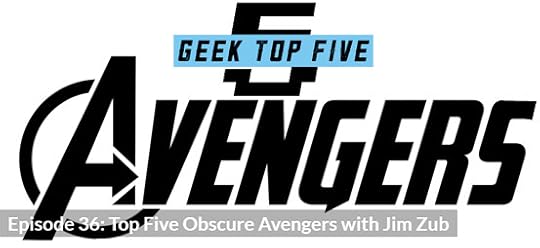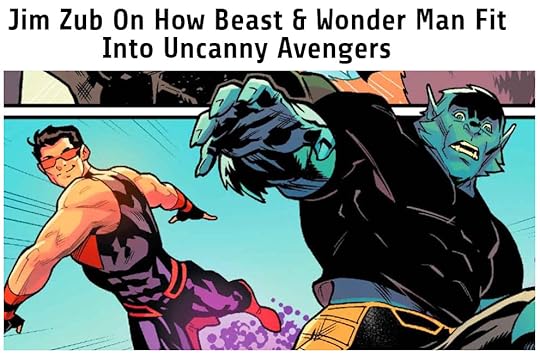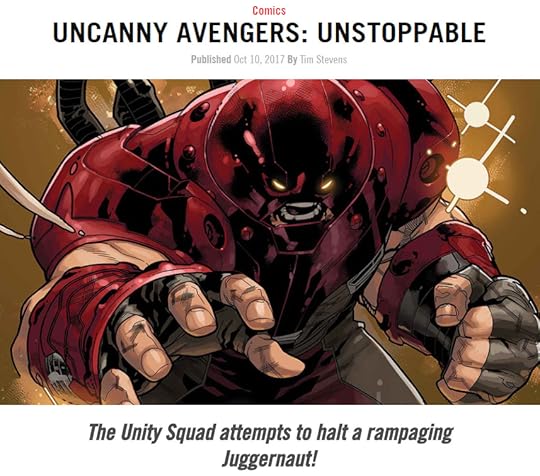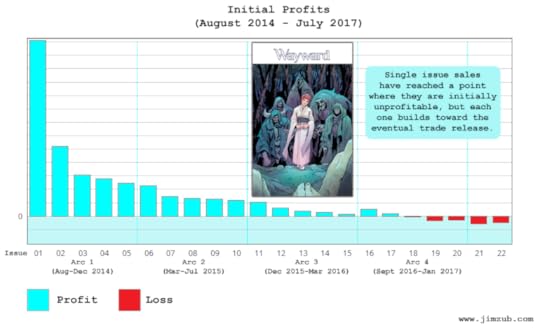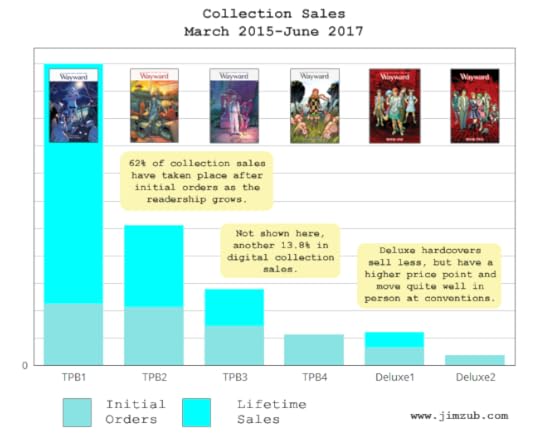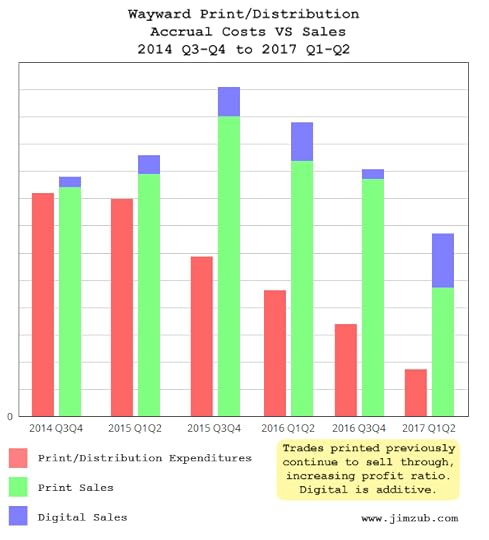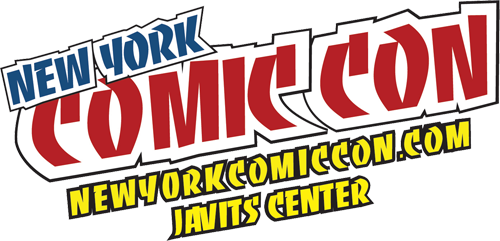Jim Zub's Blog, page 91
October 17, 2017
Arriving January- WAYWARD Vol. 5!
Arriving in January, pre-order now!
WAYWARD, VOL. 5: TETHERED SOULS TP
STORY: JIM ZUB
ART / COVER: STEVEN CUMMINGS, TAMRA BONVILLAIN
JANUARY 31 / 136 PAGES / FC / M / $16.99
Japan and Ireland are torn apart by conflict. The new power that defines the modern world rages out of control. JIM ZUB (Avengers, SKULLKICKERS) and STEVEN CUMMINGS (Deadshot, Legends of the Dark Knight) continue their supernatural spectacle that combines the camaraderie and emotion of shows like Buffy the Vampire Slayer with foreign cultures and fascinating mythological monsters. This volume includes design artwork by artist STEVEN CUMMINGS and profiles on mythical creatures by monster scholars ZACK DAVISSON and ANN O’REGAN not found in the single issues.
Collects WAYWARD #21-25
Arriving in January, pre-order now!
UNCANNY AVENGERS: UN...
Arriving in January, pre-order now!
UNCANNY AVENGERS: UNITY VOL. 5 – STARS AND GARTERS TPB
Written by JIM ZUB
Penciled by SEAN IZAAKSE
Cover by SEAN IZAAKSE
ON SALE FEBRUARY 2018
Wanda Maximoff has returned to the Avengers at last! But not everyone is happy about it. Will the team be split down the middle by the Scarlet Witch’s arrival? And as the Unity Squad faces this challenge to group harmony head-on, an old enemy makes his explosive return at the worst possible time! Our heroes’ lives will be turned upside down by friend and foe alike! Then, two of Earth’s mightiest friends reunite at last! When it comes to super-heroics, Wonder Man and the Beast have seen it, done it and gotten the T-shirt. So what happens when Hank and Simon share a beer or two? Would you believe the Juggernaut crashes the party?! There’ll be stars and garters, love and loss — but where does the Unity Squad go from here?
Collecting UNCANNY AVENGERS (2015) #26-30.
112 PGS./Rated T+ …$15.99 • ISBN: 978-1-302-90645-0
No Surrender Solicits: Avengers #675-678 Arrive in January!
AVENGERS #675
MARK WAID, AL EWING & JIM ZUB (W) • PEPE LARRAZ (A)
OCT170809 WRAPAROUND COVER BY MARK BROOKS
OCT170810 TRADING CARD VARIANT COVER BY JOHN TYLER CHRISTOPHER
OCT170811 CONNECTING VARIANT COVER (1 OF 4) BY JULIAN TOTINO TEDESCO
OCT170812 VARIANT COVER BY ALEX ROSS
OCT170813 SKETCH VARIANT COVER BY ALEX ROSS
OCT170814 AVENGERS VARIANT COVER BY MIKE MCKONE
OCT170815 YOUNG VARIANT COVER BY SKOTTIE YOUNG
OCT170807 PARTY VARIANT VARIANT BY DANIEL ACUÑA
OCT170808 SKETCH PARTY VARIANT BY DANIEL ACUÑA
NO SURRENDER Part 1
AVENGERS goes WEEKLY for the stunning sixteen-part saga that will write the end of an era! The Earth has been STOLEN! The sky burns while mysterious cosmic objects crash down from above, wreaking havoc across the world! The Avengers are the last line of defense between Earth and the mysterious forces threatening to tear it apart. It’s time to ASSEMBLE! The teams you know and love from AVENGERS, UNCANNY AVENGERS, U.S.AVENGERS and OCCUPY AVENGERS come together to face a threat beyond any they’ve faced before in a weekly epic adventure that will define the future of Earth’s Mightiest Heroes!
40 PGS./Rated T+ …$4.99
AVENGERS #676
MARK WAID, AL EWING & JIM ZUB (W) • PEPE LARRAZ (A)
Cover by MARK BROOKS
CONNECTING VARIANT COVER (2 OF 4) BY JULIAN TOTINO TEDESCO
Avengers Variant Cover by ALAN DAVIS
NO SURRENDER Part 2
NOW ON SALE WEEKLY!
The Black Order. The Lethal Legion. Two teams of powerful villains bent on destroying each other have arrived on Earth, and they don’t care who gets caught in the crossfire. But who’s pulling their strings? And what is the secret of the lost Avenger?
32 PGS./Rated T+ …$3.99
AVENGERS #677
MARK WAID, AL EWING & JIM ZUB (W) • PEPE LARRAZ (A)
Cover by MARK BROOKS
CONNECTING VARIANT COVER (3 OF 4) BY JULIAN TOTINO TEDESCO
Avengers Variant Cover by ESAD RIBIC
NO SURRENDER Part 3
NOW ON SALE WEEKLY!
Quicksilver flamed out of the Avengers, leaving devastation in his wake. But now that it’s all hands on deck, is this his chance at redemption? Or will his hunger to prove himself be his downfall?
32 PGS./Rated T+ …$3.99
AVENGERS #678
MARK WAID, AL EWING & JIM ZUB (W) • PEPE LARRAZ (A)
Cover by MARK BROOKS
CONNECTING VARIANT COVER (4 OF 4) BY JULIAN TOTINO TEDESCO
Avengers Variant Cover by Mike Del Mundo
NO SURRENDER Part 4
NOW ON SALE WEEKLY!
The Avengers are caught in a game of cosmic proportions, but they don’t know the rules – and one of them is about to pay the ultimate price! THE FIRST AVENGER FALLS!
32 PGS./Rated T+ …$3.99
Uncanny Avengers #28 Reviews
• Bleeding Cool: 8.5/10 “This is my favorite Avenger book right now, and it gets a strong recommendation. Give this one a try.”
• Comic Book University: Grade A. “One of the best comic books that I’ve read in a while…I really felt like this was written by someone who not only knows, but cares about these characters and I really haven’t seen that in a while.”
• Comic Crusaders: 8/10 “You get a good mix of character development and their histories, but doled out in manageable amounts and a little action to boot.”
• IGN: 8.5/10 “This is a terrific-looking comic book that captures a lot of the old Avengers spirit.”
• Monkeys Fighting Robots: 8/10 “For being one of the quieter starts of the new era, there wasn’t a single moment of boredom.”
• Uncanny Sessions: 9.3/10 “It continues to be awesome. We covered a lot of ground in this issue…Everyone needs to go read this”
October 16, 2017
Creator-Owned Economics: The Long, Long Game
It’s been more than two and a half years since I wrote anything about Skullkickers sales numbers. I didn’t avoid talking about it on purpose, I just felt that with the series wrapped up and Wayward still underway it should be the focal point for my financial analysis. Poring over the numbers takes time and so Wayward was the natural choice for that attention. Last week’s article about trade sales seemed to cover everything I needed to say about the current market.
Boy, was I wrong. I received my Skullkickers accrual statement late last week and the data in there kind of blew my mind. I had to put together a new financial article here to go over it.
Some back story for those of you catching up: Skullkickers was my action-comedy sword & sorcery comic released by Image Comics from 2010 to 2015. Co-created with Chris Stevens and illustrated by Edwin Huang and Misty Coats with lettering by Marshall Dillon, it was my “break-out” book, but mostly on a critical level. Fantasy can be a tough sell. Humor even more so. Put those two elements together with creators who weren’t known (at the time) and it was a challenge to make our mark. We had a wonderful and loyal core readership and good word of mouth, but never lit sales charts on fire.
Skullkickers wasn’t really profitable during its run, but it did get my name out to a much wider audience and opened the door for some of my early work-for-hire comic writing projects: 19 issues of Pathfinder at Dynamite, a Shadowman fill-in issue for Valiant, and a 2-part Legends of the Dark Knight story for DC. It was a way to show people what our team was capable of and build a body of consistent work.
When sales flagged, I ran contests, put together a ridiculous reboot parody promotion, and even started serializing the comic online for FREE to expand our readership. Each of those PR stunts helped us inch along and, in the end, we eked out 34 issues (six story arcs) and finished the story the way I intended. Skullkickers is now handsomely collected in 6 trade paperbacks or 3 deluxe hardcovers.
Every six months, I’d receive an accrual statement from Image that outlined how deep the financial hole was. They could see we were slowly digging ourselves out with digital and collection sales, but the numbers didn’t seem to be in our favor. When the series wrapped up mid-2015, I’d resigned myself to the fact that Skullkickers as a whole would probably never do better than break-even, even if it did propel me forward in terms of my writing career.
Cut to 2017. Check this out:
(Update: Image’s Accountant dropped me a line to let me know I that the way digital was shown on the latest accrual was being misinterpreted so I’ve made corrections. We are selling solidly on digital, but it’s a more reasonable percentage of our overall sales, not the gonzo spike in sales I thought it was. I’ve corrected the text and chart to reflect that change.)
Image has been smart about including Skullkickers in a lot of their digital sales, as well as putting the first 18 issues (3 story arcs) on comiXology Unlimited, a flat fee all-you-can-read service on the leading digital comics platform. Tens of thousands of new readers have discovered the series through Unlimited, and that led to more digital collection sales. The whole series is still available for FREE on our webcomic site, and yet we keep selling Skullkickers on digital platforms, month after month.
What does this mean? Well, here’s the accumulated debt versus sales chart, the one I feared would never balance out:
Thanks to slow but steady collection and digital sales, we are truly ‘in the black’. As of mid-2017, I can no longer say that Skullkickers is my lovable-yet-financially-forlorn creator-owned comic. It has finally climbed out of the pit and is holding the bloody detached head of its captor while letting out a triumphant roar.
Don’t get me wrong, I’m not going to be smoking hundred dollar bills or paying off my house with these profits. It’s quite slim right now, but it’s also open-ended; We still have print collections in stock (and our only expenditures on those right now are storage since they’re already printed and shipped to Diamond Distribution) and the digital platform never closes or runs out of copies. In six months we should make a bit more, and then a bit more, and then a bit more, hopefully ever onward into the future until every single person who reads the work I do over at Marvel realizes that the action-packed mirth they enjoy in Thunderbolts and Avengers was there right from the beginning with Skullkickers.
Image Comics (especially Publisher Eric Stephenson) deserves a ridiculous amount of credit for letting me make Skullkickers my own way, start to finish. 25 years ago, the company started with a desire to put creators first and they still do that every single day. I feel incredibly fortunate to have launched the series there and can’t think of another publisher that would have taken this on and let the long tail run its course this way.
Is Skullkickers a success? It really depends on how you measure it. This will sound dorkishly earnest, but for me it’s always been a success. We built a story I’m incredibly proud of, my love letter to Conan, D&D, and the fantasy genre as a whole, and got it out to a wider audience. It was a life-changing milestone in my creative development that led to a dozen other comic projects and where I am today. The dollars and cents are a crucial metric, of course, but not the sole reason for heading into a creative project.
Some words of warning: Please don’t use these charts as some kind of battle plan for your own comic-making dreams. Creative careers vary wildly and I’ve spoken to dozens of creators who have thrown inordinate amounts of good money after bad paying for art, coloring, lettering, printing, convention tables, and stomach pills for financial ulcers brought on by creator-owned comics. I was able to dig deep with Skullkickers because I had (and still have) a stable day job and solid freelance work paying the bills. I never put myself in a position where my day-to-day financial commitments were in doubt and if the series had never made a dime I still would have been okay.
The sales history of Skullkickers is very different from Wayward and Glitterbomb, my other two Image creator-owned series. Each series has its own unique sales history and, while this stuff is really interesting to analyze, it isn’t any kind of formula you could reproduce (and, with a 7-year bloody trek to financial sanity for SK, you probably wouldn’t want to anyway).
If you found this post interesting, feel free to let me know here (or on Twitter), share the post with your friends and consider buying some of my comics, donating to my Patreon, or buying comics from me in person if you see me at a convention.
October 15, 2017
Geek Top 5 Interview: Top 5 Obscure Avengers
I was a guest again on Geek Top 5, this time talking about the “Top 5 Obscure Avengers.”
Our interview and countdown starts at the 33 min 12 sec mark of the podcast. Give it a listen!
October 12, 2017
CBR Talks Uncanny Avengers
I spoke to Dave Richards at Comic Book Resources all about our latest Uncanny Avengers issue, with Wonder Man and the Beast teamed up again and where things may go in the future. Writing these classic characters taking stock of what they’ve done as they plan their next moves has been a blast.
October 11, 2017
Marvel.com Interview: Juggernaut VS the Uncanny Avengers
Marvel.com contributor Tim Stevens interviewed me about November’s Uncanny Avengers #29, which has Juggernaut squaring off against the Uncanny Avengers. Give it a read to find out what we’ve got planned for the team as we head into Avengers: No Surrender.
October 10, 2017
Creator-Owned Economics: Long Tail in a Moving Market
Has it really been 16 months since my previous sales update on Wayward? Wow. Time is flying, gang. I’ve been juggling a slew of different projects this year along with my day job and just didn’t have time to dig into all the numbers until things calmed down.
There’s been a lot of talk about direct market single issue sales through comic shops (also known as the “The direct market”). Sales numbers seem to be declining as retailers jump through ordering hoops for big ticket variant covers while trying not to get stuck with more non-returnable stock than they can handle. I’ve heard from quite a few creators and retailers that juggling numbers on major releases from the Big Two doesn’t leave a lot of time/money to support other publishers, and what is there tends to go to recognizable brands with media pull.
As I’ve mentioned in previous posts, the landscape of media is changing. Every form of entertainment has been shaken up by the digital revolution and a generation of consumers who are growing up with new paradigms that don’t involve owning physical media.
So, with that in mind, here’s how Wayward is faring in a tough market: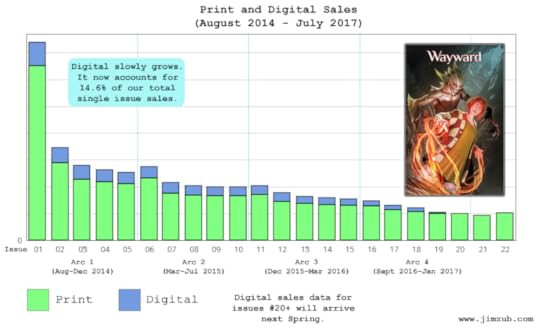
Once again, we’re looking at a classic case of ‘standard market attrition.’ The drops between each issue aren’t severe, but they do start to add up issue after issue, leading to an overall decline. It can be tough to maintain visibility for a creator-owned series that’s long in the tooth (and yes, in this market, Wayward has more issues than many rebooted superhero titles so it looks comparatively old). Comic news sites and reviewers want to talk about the latest and greatest, not a series that’s more than 3 years old with 20+ issues. So, what does this mean for our single issue sales profitability?
As of issue #18 we’re releasing issues with an initial loss. Obviously, that’s not an ideal situation but I could see where the numbers were leading us and wasn’t surprised. This matches the overall softness of the comic market as a whole. Retailers are cutting purchasing budgets to the bone and many titles are losing ‘shelf copies’, extra copies ordered to see if they can be sold to customers who haven’t subscribed to a title. I’ve been to more and more comic shops where they order single issues for their pullbox customers and only have shelf copies for the biggest releases each week. It’s understandable, given the current sales environment, but it does make it harder for new readers to discover titles…
…Or, does it?
The simple truth is that the market has moved to trade reading. Affordable, durable, easy to lend to a friend or give as a gift, trade paperbacks are now the market for many titles. Wayward trade paperback sales continue to grow and that really drives us forward at this point. Direct market comic retailers support Wayward with their trade orders, but more than half of our trade sales now come from bookstores and other outlets. Initial direct market orders are pretty good, but the long tail of continued sales through other channels keeps us growing year after year. Good word of mouth from people like you keeps us going.
In addition to those single issues and trades, we had two huge visibility boosts that don’t show up properly on these sales charts:
• In early 2016, Image Comics had a Humble Bundle of digital comics promoting diversity and human rights. Supporters who pledged over $20 received a digital copy of Wayward Deluxe Book 1, our packed-to-the-brim issue #1-10 collection with over 80 pages of back matter. That led to thousands of new readers diving into the series and an accompanying boost afterward for digital trade sales.
• Wayward Vol. 1: String Theory is part of comiXology Unlimited, a monthly flat fee all-you-can-read service offered by the leading platform for digital comics. We only get paid a small amount per downloaded trade, but it’s the visibility boost that’s really helped. Tens of thousands of people have read Wayward Vol. 1 through the Unlimited platform.
How’s it looking in 6 month increments? Let’s see-
Image printed a huge run of Wayward Volume 1 and 2 and those trades keep selling, so the cost of keeping Wayward in stock stays low while profits continue year after year.
Okay, here’s profit with everything factored in: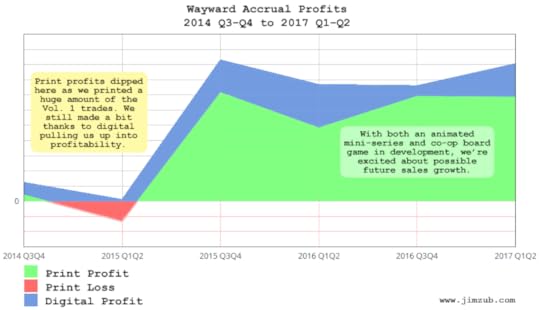
In addition to direct market and bookstore sales, this chart also includes a few foreign deals that have been struck to bring Wayward out in other languages, most notably in French from Glénat Comics, with two volumes out so far. Foreign deals are the best because the foreign publisher handles translation, printing, and advertising. For them it’s way cheaper than creating all-new content and for us it rules because we just hand over the print files and get paid.
That small dip in early 2015 was the cost of printing Wayward Vol. 1 with a deep stock to keep us rolling over the long haul, and it’s been pretty smooth ever since. Trade and digital sales have overtaken temporary losses incurred from single issue release. We’re continuing to build our readership in comic shops, bookstores, and online.
Image’s incredible ownership and profit sharing model is unlike any other creator-owned deal in the market. Our small monthly single issue sales and growing trade sales do well enough that Wayward is still Steven’s full-time job (living in Yokohama with a wife and two wonderful kids) and pays a competitive page rate to Tamra, Marshall, Zack, Ann, and myself while giving us the flexibility to make the story exactly the way we want. We don’t get the press coverage of Walking Dead, Saga, Wicked + Divine, Rat Queens or Sex Criminals, but we are solidly plugging away. The additional visibility of an anime series and co-op board game in development could mean even stronger sales for 2018 and beyond.
If you take away anything from this post, let it be this: When fans or news sites only obsess over direct market single issue sales numbers from Comichron (which are not complete, but do provide an overall sense of market leaders and attrition), they are ignorant of a much larger overall market. Comic companies are not obligated to post their sales numbers, but that obfuscation has unfortunately led to a ridiculous amount of armchair quarterbacking by people who cannot see the forest for the trees and are woefully ill-informed about what sells and where. If you only looked at monthly print single issue sales you would assume Wayward was doomed over a year ago, but it’s just not true. The market has shifted and will continue to do so. Readers, retailers, and publishers need to adjust their perception of the market, if they haven’t already.
As always, a quick warning: The above charts only reflect the state of Wayward, my creator-owned comic series. I believe they’re indicative of some broader industry trends, but every series has a different sales cycle depending on the creators involved, publisher, marketing, and whims of the market. Skullkickers and Glitterbomb, my other creator-owned series, have been very different in terms of sales and profitability. Don’t build your own financial plans solely based on these articles.
If you found this post interesting, feel free to let me know here (or on Twitter), share the post with your friends and consider buying some of my comics, donating to my Patreon, or buying comics from me in person if you see me at a convention.
October 4, 2017
Zub at New York Comic Con 2017!
For the first time in a long, long time, I will be at New York Comic Con, but don’t have a table location! I’m headed to the show to do promotion, panels, signings, and meetings. I’m really looking forward to free roaming the floor and spending time with friends. Pals, if you want to hang out, drop me a line!
Here’s where you’ll definitely be able to find me:
THURSDAY October 05
5:00 – 5:45pm Signing at the MARVEL Booth (BOOTH #1354)
SATURDAY October 07
11:15 AM – 12:15 PM Cup O’Joe Presents MARVEL LEGACY: AVENGERS – ROOM 1A21
At this marvelous panel, be the first to hear the latest news about the Avengers, as well as their allies and enemies! A super-team consisting of Executive Editor Tom Brevoort, Michele Bandini (Captain Marvel), Ta-Nehisi Coates (Black Panther), Al Ewing (Royals, U.S.Avengers), Nick Spencer (Captain America), Margaret Stohl (Captain Marvel), and Jim Zub (Uncanny Avengers) will assemble on stage to provide the answers to your burning questions.
SUNDAY October 08, 2017
1:30 PM – 2:30 PM MARVEL: True Believers – ROOM 1A10
Join Executive Editor Nick Lowe, Greg Pak (Incredible Hulk), Gabby Rivera (America), and Jim Zub (Uncanny Avengers) for a private panel discussion of what’s happening inside the Marvel Universe. Get FREE merchandise, never-before-seen sneak peeks of upcoming comics, Q&A session and more! Not to be missed! Open only to Marvel Unlimited Plus members and Marvel MasterCard cardholders. Room 1A10


